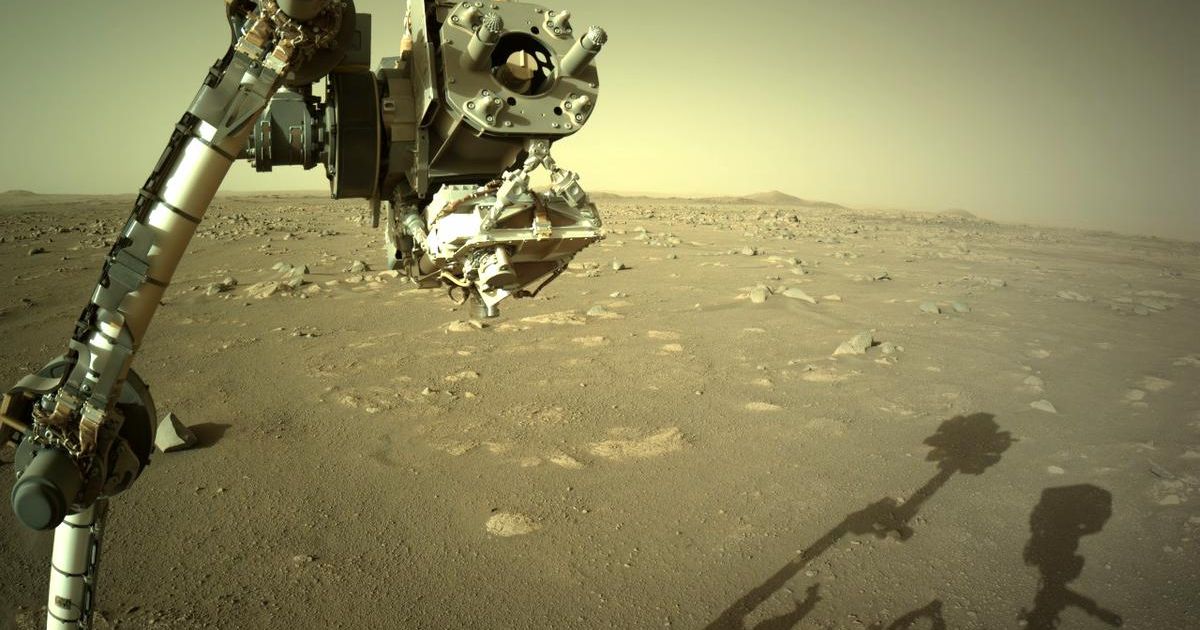
Snap. Whoosh. Ping.
The Mars Perseverance rover, the first robot to record Martian sounds with a real microphone, has already picked up some eerie, extraterrestrial recordings. The sounds, available below, include the rover’s metallic wheels rumbling over the desert ground, a laser zapping a rock 30 times, and the blowing Martian wind.
“On one hand they sound very mundane,” Bruce Betts, a scientist at The Planetary Society, an organization that promotes the exploration of space, told Mashable. “But when you realize you’re listening to sounds on another planet, of our own machine moving on the surface, and a laser vaporing a little bit of rock, suddenly these become profound and awe-inspiring.”
Here they are. NASA recommends using headphones.
A Martian drive
On sol 16 (a sol is a 24-hour-39.5-minute-long Martian day), Perseverance recorded 16 minutes of the rover driving over the rocky Mars’ ground. The clip below is a 90-second edit of those sounds.
You can hear pings, scrapes, and thuds as the six metal wheels roll over the hard surface.
“A lot of people, when they see the images, don’t appreciate that the wheels are metal,” Vandi Verma, a senior engineer and rover driver at NASA’s Jet Propulsion Laboratory in Southern California, said in a statement. “When you’re driving with these wheels on rocks, it’s actually very noisy.”
Laser zapping rocks
Perseverance zapped a Martian rock 30 times with a laser. They sound like snaps or cracks.
“These sounds are exactly as you would hear them with your own ears if you were standing on the surface of Mars,” Naomi Murdoch, a rover engineer and researcher at ISAE-SUPAERO (France’s Higher Institute of Aeronautics and Space), said at a press conference on March 10.
Why zap a rock with a laser?
There a lot of places for Perseverance to potentially visit as it seeks evidence of past microbial life, or at least conditions for life. The laser helps identify the most promising places to go. Perseverance’s SuperCam instrument, which sits atop the robot’s mast like a crow’s nest on a ship, is equipped with the laser. Each laser strike concentrates the power of one million light bulbs onto an area the size of a pinhead. As Mashable previously reported:
The laser’s energy excites the target’s atoms, producing ephemeral flickers. By looking at these flashes of light, each with a unique signature, the SuperCam can then analyze what any given target is made out of, like organic materials microbes may have once munched on.
What’s more, NASA planetary scientists can also listen to zapping sounds on different surfaces, which reveals more information about the rocks, like their hardness. In a far-off world brimming with new places to go, the more information, the better.
Martian wind
The first sounds recorded on Mars were the wind. At about six seconds into the short clip, you hear a wind gust on Mars, recorded on Feb. 20, 2021.
There will almost certainly be many more Martian recordings to come. “The fact they ran [the microphone] in the first drive shows they’re interested in using it,” said Betts. (The rover’s main microphone is also built into the SuperCam.)
What is Betts interested in hearing next? Different rover sounds, like the drill and the rover zapping different rocks. And, most of all, something that would require quite a bit of luck: a dust devil. But the microphone would need to be opportunistically recording when a devil came whirling close by, something that’s nearly impossible to predict. “One of my dream sounds would be hearing a dust devil,” said Betts. “But you’d have to get lucky.”
See Also: The space race forged immortal rock and roll guitars
Perhaps future missions — to other wild worlds in our solar system like the moons Titan or Europa — will one day beam back extraterrestrial sounds, too.
“I have a feeling that once you’ve had success with microphones, that’ll you start seeing them incorporated in future spacecraft,” said Betts.
